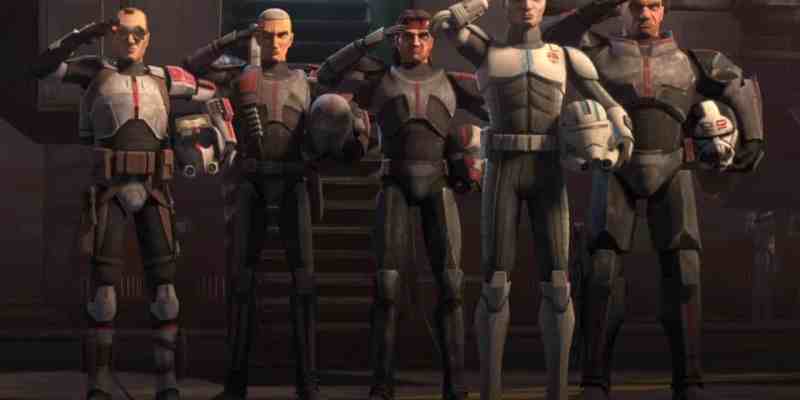The future of Star Wars seems to lie on television for the time being. That might be for the best.
It was confirmed this week that Disney+ would be producing an animated Star Wars series named The Bad Batch, featuring the characters introduced in the opening arc of the closing season of The Clone Wars. Disney has also stressed that the second season of The Mandalorian will not be delayed by the ongoing pandemic. This is coupled with other suggestions that — despite behind-the-scenes setbacks — the studio is pushing ahead with a series starring Ewan McGregor as Obi-Wan Kenobi.
Of course, there is some suggestion that the cinematic universe is continuing to percolate. Rian Johnson’s original trilogy is reportedly still happening. There are rumors that the cross-media “High Republic” initiative might eventually lead to a cinematic release. However, the cinematic wing of the Star Wars universe has been relatively quiet lately, perhaps still decompressing after the creative and (relative) commercial disappointment of The Rise of Skywalker.
Part of this is undoubtedly savvy brand management from Disney. A cinematic “breather” for the franchise is assuredly a good thing. To misquote a cliché, absence makes the fandom grow fonder. At least part of the declining box office for Solo: A Star Wars Story and The Rise of Skywalker was down to the fact that Star Wars films had gone from era-defining blockbusters to clockwork annual releases. There was nothing unique about them, nothing that demanded to be seen.

The Phantom Menace and The Force Awakens were record-smashing blockbuster behemoths on a scale their sequels could not match. This was in part because they arrived to a theatrical market starved of new Star Wars content. For many viewers, those films represented the first chance to see a new Star Wars film in a cinema or to take a younger relative. Disney understands the appeal of building demand through forced scarcity. This is the company that invented “the Disney Vault.”
However, there’s more to it than that. Pushing Star Wars away from the blockbuster film series and towards assorted television series is a move that acknowledges a simple and inescapable truth about the current reality of the property. Star Wars is not the cultural monolith that it was in 1977, and it hasn’t been for a very long time. Arguably every Star Wars movie since The Empire Strikes Back — currently enjoying a box office-topping re-release — has struggled with that fact.
Due to the amount of money invested, and the box office returns needed, modern blockbusters have to appeal to as broad an audience as possible. A large part of this is simple management of audience expectations. The Marvel Cinematic Universe has continued to satisfy its core audience by adhering to a consistent “house style,” ensuring that the audience knows exactly what it is going to get from the franchise at a regularly scheduled interval. There are very few surprises.
This approach doesn’t work for Star Wars. In fact, it’s arguable that trying to force Star Wars into a similar shape to the MCU ultimately accelerated these problems — pushing for a tighter, more regular release schedule contributed to the decline of Star Wars films as cultural events while resulting in bland and indistinct films like Solo: A Star Wars Story. There are historical reasons for this, largely down to the cinematic franchise’s history of staggered releases.

Every Star Wars blockbuster has to make a choice that restricts its ability to appeal to as broad an audience as possible. Every Star Wars film has to decide on its target audience: Is it aimed at the kids currently sitting in the audience, or is it aimed at the kids sitting in the audience back in 1977? This conflict was evident as early as the release of Return of the Jedi in 1984, where the same teenagers who had seen Star Wars as children in 1977 were horrified by the inclusion of the toyetic Ewoks.
The MCU has been able to shepherd along audience members from Iron Man to Avengers: Endgame by maintaining a steady release schedule. With only months between each release, there’s no time for audience expectations to calcify into a standard against which the franchise might be measured. In contrast, Star Wars was absent from the big screen for extended periods, in which the cultural memory of the films solidified into an idea of what a Star Wars film “should” be.
There are plenty of legitimate criticisms to be made of the prequels and sequels. There is also a lot of goldilocks criticism. The prequels were too childish, with characters like Jar-Jar Binks aimed at kids watching for the first time in 1999. In contrast, the sequels indulged too eagerly in nostalgia, pandering too deferentially to the older audience members who fetishized the original trilogy. The prequels didn’t look enough like Star Wars. The sequels looked too much like Star Wars.
Indeed, the sequel trilogy often felt like a tug-of-war between these demographics. Some original trilogy fans felt like Luke Skywalker (Mark Hamill) was treated disrespectfully, despite the fact that he was treated like every older character in the franchise. Some sequel trilogy fans felt new characters like Finn (John Boyega) were short-changed to make room for nostalgia. Prequel trilogy fans felt mostly ignored and overlooked.

Ever conscious of brand management, Disney invested a lot of effort into squaring this circle. One of the biggest issues with The Rise of Skywalker is the franchise trying to have its cake and eat it, to avoid committing to anything that might alienate any potential audience. Those fans who shipped Kylo Ren (Adam Driver) and Rey (Daisy Ridley) could get a brief kiss between them, for example. However, to avoid alienating other fans, it was clarified that the kiss was one of “gratitude.”
This is why so much of the debate around The Rise of Skywalker inevitably circles back to hypothetical or alternate versions of the film. This is also why so much of the news cycle following the release was fixated on Disney’s efforts to rewrite certain elements of the narrative to avoid committing to one clear interpretation or another. The production and afterlife of The Rise of Skywalker demonstrated that there was no longer a single monolithic idea of who Star Wars was for.
As such, the end of the Skywalker Saga is a good thing. It is also why more diversification in terms of Star Wars content provides a viable roadmap for the future of the franchise. Streaming series are not burdened with the same demand of mass appeal that shapes big blockbusters. Instead, they can “narrowcast” to specific sectors of the audience. The Disney+ user base is most recently cited at 54.5 million subscribers, but not all of them are subscribing for one thing.
Streaming shows are not required to service all masters, to satisfy every possible potential Star Wars fan. Instead, pushing Star Wars towards television and even smaller movies allows the franchise to offer a broader menu. The Mandalorian can deliver safe old-school nostalgia. The Clone Wars can satisfy those fans who came of age with the prequel trilogy. Jedi Temple Challenge can shamelessly appeal to the kinds of younger audience members who respond to Ahmed Best as Jar-Jar Binks.

Of course, there needs to be more than just nostalgia. One of the benefits of having multiple Star Trek shows on television concurrently during the 1990s was that the relative safety of shows like The Next Generation and Voyager allowed the creative team on Deep Space Nine to push the franchise out of its comfort zone. If Star Wars is to truly thrive as it accepts the erosion of its monolithic blockbuster identity, it needs to embrace something similarly bold and daring.
This may lead to a healthier fandom environment and allow the franchise to grow. The Last Jedi was a well-reviewed, well-liked, and financially successful blockbuster that provoked certain elements of a nostalgic fandom for its perceived iconoclasm. Perhaps those fans might be more willing to accept something similarly bold and progressive if afforded the familiar comforts of alternatives like The Clone Wars or The Mandalorian, spared the burden of being the “one, true” iteration of Star Wars.
Star Wars is not just one thing. It hasn’t been just one thing for a very long time. Moving towards more streaming options and more diverse cinematic releases would accept this reality. Instead of attempting to construct gigantic blockbusters that try to be everything to everyone and end up signifying nothing, it’s possible for individual options to offer something for anyone who wants it. It might finally offer a new hope to the franchise.
